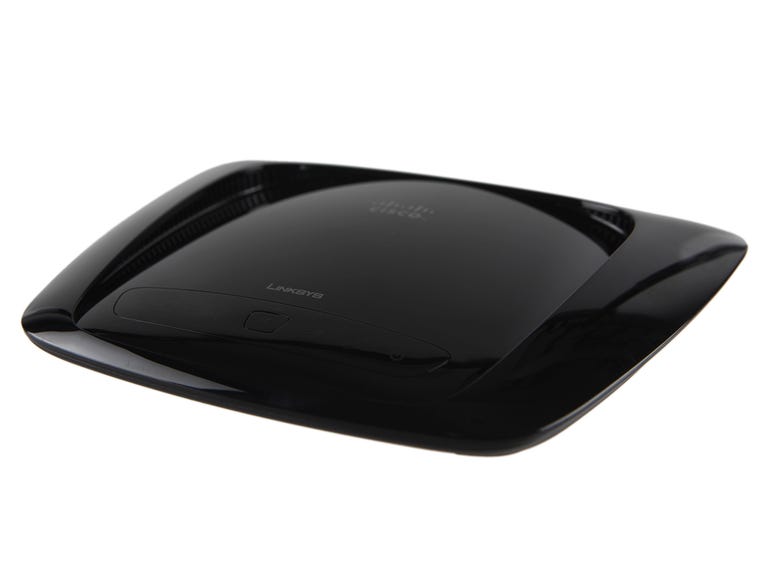If you're looking for a simple workhorse Wireless-N router, you'll be happy with the WRT160N, especially considering you can get it online for $80 or less.
The Good
The Bad
The Bottom Line
Overall, the WRT160N is much like Linksys' WRT320N router, minus the support for the 5Ghz band and Gigabit Ethernet. Nonetheless, it retains the same compact and sleek-looking UFO-shaped design with internal antennas.
The WRT160N achieved decent throughput speeds, especially in mixed mode and range testing. It also comes with a good set of networking features and a useful desktop application that helps set up and manage both the router and the local network. Also, you can use its Web interface to access its advanced features.
Design and ease of use
Similar to Linksys' recent routers such as the WRT320N, the WRT400N and the WRT310N, the WRT160N sports an aesthetically pleasing sleek, flat, UFO-shaped chassis. The router's antennas are internal, allowing it to be more compact than other, similarly sized routers.
On the back the WRT160N has four network ports, standard for most routers. Unfortunately, these ports do not adhere to the Gigabit Ethernet standard, which allows for throughput speeds of up to 1,000Mbps. Instead, the ports on the WRT160N are capped at 100Mbps, so if you use the router for wired connections, you'll be missing out on the higher speed. Also disappointing is the omission of a USB port, which would allow for supporting a printer or network storage device.
On the front of the router is an array of light emitting diodes that show the status of the ports, the wireless network, and the Internet. In the middle of the LEDs is the Wi-Fi protected setup (WPS) button, which initiates a window of time when you can hook other WPS-compliant wireless clients to the network without having to enter an encryption key. For example if you bring a WPS-enabled client close to the router and press the button on both devices, they will be connected automatically.
The WRT160N comes with Linksys' EasyLink Advisor software for both PC and Mac. The software is well-designed and offers a well-thought-out, step-by-step setup process that even the most novice of users can follow. Savvy users may want to skip it in favor of the Web interface, which is more comprehensive than the desktop software.
We had no problems and were able to get the Linksys WRT160N router up and running for testing within a few minutes.
Features
The WRT160N router has nearly the same Web interface and networking features as the other recent Linksys routers. The interface allows access to the routers' long list of advanced features. We especially liked its elaborate content filtering system, called "Access Restrictions," that allows for restricting or filtering Internet access of particular networked computers. This is helpful if you want to block certain computers from certain Web sites. The "Applications & Gaming" feature lets you set up port forwarding and triggering to set specific ports for specific applications such as games, remote desktop, or FTP and HTTP servers. You can also conveniently reserve static IP addresses to certain computers in the network, making the port forwarding much more relevant and easy to do. If you want to create a VPN connection, an FTP access, or a remote desktop connection to a certain computer in the network, you will find this handy and convenient.
The desktop software also offers some original post-setup features. We especially liked the ability to see a map of all clients connected to the network and the ability to manage each of them in real time. For example, if you see an unidentified device connected to the network, the software allows you to mark it in red to distinguish it from other known devices. If a client in the network has EasyLink Advisor installed, you can do more, such as viewing its complete status including its MAC, IP address, OS and CPU information, and more.
For security, the WRT160N supports all available wireless encryption standards including WEP, WPA personal, and WPA Enterprise. The router allows for VPN pass-through for all existing VPN protocols including IPsec, L2TP, and PPTP. If you're using the router from your home, you can use a VPN client to access your work offices via a VPN connection.
Apart from
Performance
The WRT160N's performance met our expectation for a single-band Wireless-N router.
On our throughput test, where the router was set to offer the best possible performance, it achieved 40.3Mbps, just a little slower than the 45.3Mbps of the WRT320 and a bit faster than the 40.1Mbps of the WRT400N. At this speed the WRT160N would take about 99 seconds to finish transmitting 500MB of data over its wireless network.
On our range test, where the router was 100 feet away from the client, it got 36.8Mbps, which was faster than the WRT320N and about the same as the WRT400N.
In mixed mode, the WRT160N remained at 36.7Mbps. The mixed-mode test was done with the router set to work with both Wireless-N and legacy Wireless-G simultaneously.
We noticed that the WRT160N, like most of Linksys' recent routers, offer consistent performance with small degradation over range and mixed mode, which is impressive. The Belkin N+, for example, has a faster throughput speed of 55.4Mbps, but its range speed reduced by nearly half to 29.4Mbps.
(Longer bars indicate better performance)
| Mixed mode | Range | Throughput |
We were also satisfied with the WRT160N's 270-foot range in our testing facility, which is not range optimized. In the real world, depending on your location, you might get even longer range.
Service and support
Like with its other new routers, Linksys backs the WRT160N with a one-year limited warranty. This is short but standard for most routers on the market. Linksys' toll-free phone support is available 24-7, as is online chat with a support representative. Linksys' Web site includes software, drivers, firmware downloads, as well as an FAQ section.




